Making Different Decisions: Demonstrating the Influence of Climate Model Uncertainty on Adaptation Pathways
Abstract
1. Introduction
2. Materials and Methods
2.1. Case Study
2.2. Methodology
2.2.1. Hydrology: Boundary Conditions
2.2.2. Uncertainty Quantification
2.2.3. Hydraulic Model
2.2.4. Damage Estimation
2.2.5. Adaptation Scenarios
3. Results
3.1. Hydrology
3.2. Probabilistic Hazard Maps
3.3. Damage Estimation
3.4. Adaptation Pathways
4. Discussion
4.1. Hydrology
4.2. Probabilistic Hazard Maps
4.3. Damage Estimation
4.4. Adaptation Pathways
4.5. Further Work
4.6. Assumptions and Limitations
5. Conclusions
Author Contributions
Funding
Data Availability Statement
Acknowledgments
Conflicts of Interest
Abbreviations
| AMAX | Annual maximum |
| ATP | Adaptation tipping point |
| BFI | Base Flow Index |
| CBA | Cost–benefit analyses |
| CDF | Cumulative density function |
| CI | Confidence interval |
| CMIP | Coupled Model Intercomparison Project |
| CORDEX | Coordinated Regional Climate Downscaling EXperiment |
| CRS | Coordinates Reference System |
| DEM | Digital Elevation Model |
| EV | Extreme value |
| ESGF | Earth System Grid Federation |
| FEH | Flood Estimation Handbook |
| FMC | Full Monte Carlo |
| GCM | General Circulation Model |
| GEV | Generalised extreme value |
| GHG | Greenhouse gas |
| HOST | Hydrology of Soil Types |
| LHS | Latin Hypercube Sampling |
| MC | Monte Carlo |
| MCM | Multi-Coloured Manual |
| MLE | Maximum Likelihood Estimation |
| NRFA | National River Flow Archive |
| NFM | Natural flood management |
| Probability density function | |
| PFM | Probabilistic flood map |
| RCM | Regional climate model |
| RCP | Representative Concentration Pathway |
| ROA | Real options analysis |
| SAAR | Average annual rainfall in the standard period (1961–1990) |
| ScotLIS | Scotland Land Information Service |
| SPD | Scottish Property Database |
| SPR | Standard percentage runoff |
| SEPA | Scottish Environmental Protection Agency |
| TFRCD | Task Force for Regional Climate Downscaling |
| UKCEH | UK Centre for Ecology & Hydrology |
| WCRP | World Climate Research Programme |
Appendix A
Appendix A.1
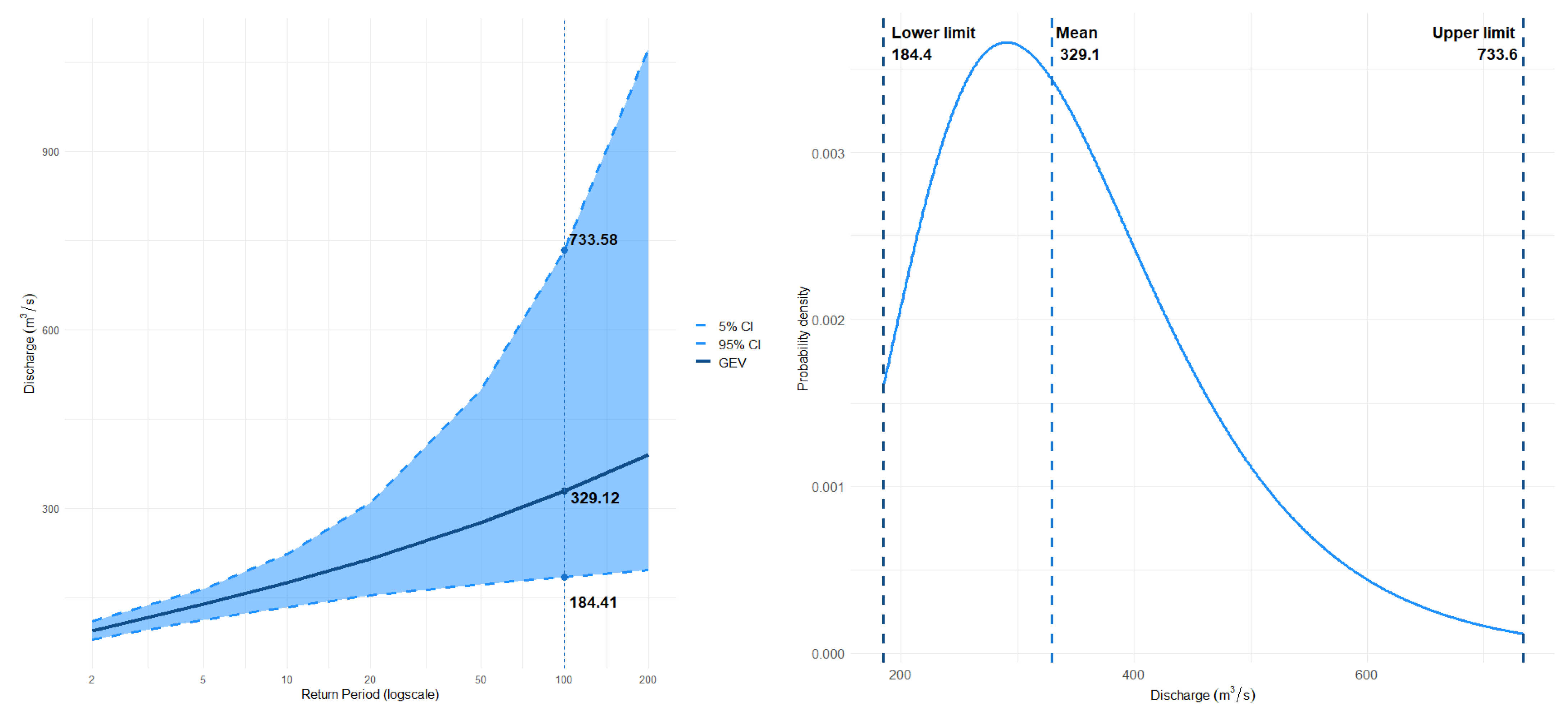
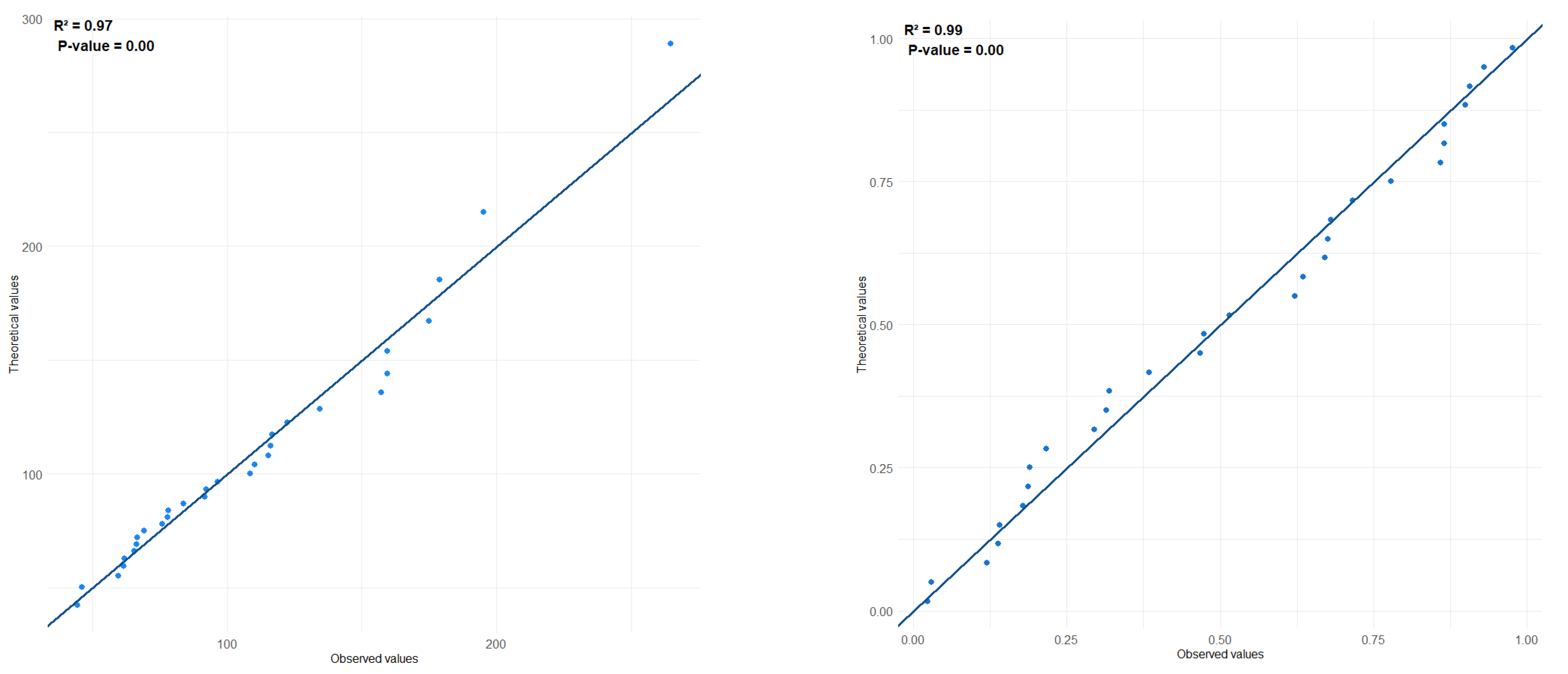
Appendix A.2
| Driving Model (GCM) | Institution | RCM |
|---|---|---|
| ICHEC-EC-EARTH | CLM (Climate-Limited Area Modelling) | CCLM4-8-17_1 |
| data | CCLM4-8-17_3 | |
| CCLM4-8-17_4 | ||
| CCLM4-8-17_5 | ||
| KNMI (Koninklijk Nederlands Metrologisch Institute) | RACMO22E_2 | |
| RACMO22E_3 | ||
| RACMO22E_4 | ||
| RACMO22E_5 RACMO22E_6 | ||
| CLM (Climate-Limited Area Modelling) | COSMO-crCLIM-v1-1_1 | |
| COSMO-crCLIM-v1-1_2 | ||
| COSMO-crCLIM-v1-1_3 | ||
| COSMO-crCLIM-v1-1_4 | ||
| MOHC (Met Office Hadley Centre) | HadREM3-GA7-05_1 | |
| HadREM3-GA7-05_3 | ||
| HadREM3-GA7-05_4 | ||
| DMI (Danmarks Meterologiske Institut) | HIRHAM5_1 | |
| HIRHAM5_2 | ||
| HIRHAM5_3 | ||
| HIRHAM5_5 | ||
| HIRHAM5_6 | ||
| MPI-ESM1-M | MPI-M (Max Planck Institute for Meteorology) | REMO2009 |
| NCC-NorESM1-M | GERICS (Climate Service Center Germany) | REMO2015_2 |
| REMO2015_3 | ||
| REMO2015_4 | ||
| REMO2015_5 | ||
| REMO2015_6 | ||
| REMO2015_7 |
Appendix A.3
| Climate Model | Baseline | Near Future | Far Future | |||
|---|---|---|---|---|---|---|
| Min. Lower (m3/s) | Max. Upper (m3/s) | Min. Lower (m3/s) | Max. Upper (m3/s) | Min. Lower (m3/s) | Max. Upper (m3/s) | |
| CCLM4-8-17_1 | 192.9 | 378.2 | 172.9 | 397.8 | 121.0 | 209.9 |
| CCLM4-8-17_3 | 175.1 | 407.9 | 149.1 | 502.9 | 131.4 | 574.4 |
| CCLM4-8-17_4 | 186.5 | 471.7 | 158.1 | 366.0 | 139.4 | 290.3 |
| CCLM4-8-17_5 | 173.6 | 582.9 | 160.8 | 233.8 | 109.8 | 170.2 |
| RACMO22E_2 | 212.9 | 563.7 | 219.6 | 928.9 | 137.6 | 652.0 |
| RACMO22E_3 | 225.2 | 601.6 | 211.2 | 317.2 | 167.5 | 718.0 |
| RACMO22E_4 | 170.3 | 621.1 | 135.4 | 228.6 | 119.9 | 355.7 |
| RACMO22E_5 | 222.8 | 754.3 | 190.9 | 617.3 | 123.0 | 455.9 |
| RACMO22E_6 | ||||||
| COSMO-crCLIM-v1-1_1 | 184.1 | 490.2 | 172.0 | 263.2 | 181.7 | 368.5 |
| COSMO-crCLIM-v1-1_2 | 161.5 | 526.8 | 185.4 | 554.9 | 216.9 | 754.8 |
| COSMO-crCLIM-v1-1_3 | 193.6 | 688.9 | 192.2 | 614.8 | 194.1 | 365.2 |
| COSMO-crCLIM-v1-1_4 | 200.1 | 474.1 | 216.7 | 733.4 | 198.8 | 491.9 |
| HadREM3-GA7-05_1 | 213.4 | 444.4 | 218.7 | 380.5 | 229.5 | 338.5 |
| HadREM3-GA7-05_3 | 156.2 | 422.6 | 153.1 | 279.1 | 185.9 | 767.2 |
| HadREM3-GA7-05_4 | 187.2 | 665.9 | 211.2 | 544.9 | 187.1 | 243.6 |
| HIRHAM5_1 | 197.4 | 427.3 | 205.7 | 325.5 | 209.9 | 396.5 |
| HIRHAM5_2 | 125.5 | 765.5 | 128.1 | 619.5 | 226.8 | 1075.9 |
| HIRHAM5_3 | 135.6 | 763.2 | 133.7 | 356.1 | 135.9 | 489.8 |
| HIRHAM5_5 | 163.5 | 771.6 | 243.1 | 928.9 | 123.7 | 251.6 |
| HIRHAM5_6 | 134.3 | 762.4 | 129.7 | 928.9 | 135.8 | 556.8 |
| REMO2009 | 124.0 | 647.8 | 169.6 | 795.9 | 172.5 | 595.6 |
| REMO2015_2 | 198.4 | 593.9 | 222.5 | 664.7 | 219.3 | 489.3 |
| REMO2015_3 | 199.9 | 656.9 | 196.7 | 343.6 | 209.4 | 573.8 |
| REMO2015_4 | 183.6 | 575.0 | 210.0 | 928.9 | 167.0 | 198.2 |
| REMO2015_5 | 195.8 | 595.8 | 235.1 | 464.3 | 240.4 | 542.5 |
| REMO2015_6 | 219.0 | 777.8 | 210.5 | 583.9 | 208.4 | 561.7 |
| REMO2015_7 | 197.7 | 550.9 | 245.6 | 928.9 | 207.5 | 501.8 |
| Min lower limit | 124.0 | 128.1 | 109.8 | |||
| Max. upper limit | 777.8 | 928.9 | 1075.9 | |||
Appendix B
| Scenario | Time Horizon | Adaptation Actions | Modified Parameters | Description |
|---|---|---|---|---|
| No adaptation | Baseline Near future Far future | None | None | None |
| Do minimum | Near future | Direct defences | DEM, Manning “n” | Levels raised by 1.5 m at location of proposed walls to the WWTP and commercial properties Residential property thresholds raised by 0.3 m N = 1 for impermeable barriers |
| Old canal restoration | DEM, bed, width, bank, Manning “n” | Includes the old canal channel N = 0.05 | ||
| Storage | Near future Far future | Increase floodplain storage | DEM, bed, width, bank, Manning “n” | Uniformly reduced elevations relative to the river channel elevations Setting back and reprofiling of embankments N = 0.05 |
| Woodlands | Near future Far future | Riparian woodland creation along the riverbanks | DEM, bed, width, bank, Manning “n” | As above N = 0.06 (near future); n = 0.1 (far future) |
| Land-use management | Far future | Whole-catchment woodland creation | Upstream inflows | Reduced peak flow by 3.5% Delay to peak flow by 1 h |
| Scenario | Time Horizon | Total Estimated Damage (£) | Exceeds ATP? |
|---|---|---|---|
| ATP | January 2016 | 147,933.66 | |
| No adaptation | Baseline | 175,576.20 | Y |
| Near future | 273,502.31 | Y | |
| Far future | 228,929.28 | Y | |
| Do minimum | Near future | 261,469.62 | Y |
| Storage | Near future | 224,552.60 | Y |
| Far future | 153,918.23 | Y | |
| Woodlands | Near future | 224,740.00 | Y |
| Far future | 163,360.93 | Y | |
| Land-use management | Far future | 159,968.55 | Y |
References
- Ritchie, H.; Rosado, P. Global Damage Costs from Natural Disasters. Natural Disasters. Available online: https://ourworldindata.org/grapher/damage-costs-from-natural-disasters (accessed on 2 August 2024).
- Sayers, P.B.; Horritt, M.S.; Penning-Rowsell, E.; Mckenzie, A. Climate Change Risk Assessment 2017: Projections of Future Flood Risk in the UK. 2015. Available online: www.sayersandpartners.co.uk (accessed on 18 January 2025).
- Caretta, M.A.; Mukherji, A.; Arfanuzzaman, M.; Betts, R.A.; Gelfan, A.; Hirabayashi, Y.; Lissner, T.K.; Liu, J.; Gunn, E.L.; Morgan, R.; et al. Water. In Climate Change 2022: Impacts, Adaptation and Vulnerability; Contribution of Working Group II to the Sixth Assessment Report of the Intergovernmental Panel on Climate Change; Cambridge University Press: Cambridge, UK; New York, NY, USA, 2022; pp. 551–712. [Google Scholar] [CrossRef]
- Aitken, G.; Beevers, L.; Christie, M.A. Multi-Level Monte Carlo Models for Flood Inundation Uncertainty Quantification. Water Resour. Res. 2022, 58, e2022WR032599. [Google Scholar] [CrossRef]
- Beevers, L.; Collet, L.; Aitken, G.; Maravat, C.; Visser, A. The influence of climate model uncertainty on fluvial flood hazard estimation. Nat. Hazards 2020, 104, 2489–2510. [Google Scholar] [CrossRef]
- Hall, J.; Solomatine, D. A framework for uncertainty analysis in flood risk management decisions. Int. J. River Basin Manag. 2008, 6, 85–98. [Google Scholar] [CrossRef]
- Di Baldassarre, G.; Montanari, A. Hydrology and Earth System Sciences Uncertainty in River Discharge Observations: A Quantitative Analysis. 2009. Available online: www.hydrol-earth-syst-sci.net/13/913/2009/ (accessed on 15 July 2024).
- Collet, L.; Beevers, L.; Stewart, M.D. Decision-Making and Flood Risk Uncertainty: Statistical Data Set Analysis for Flood Risk Assessment. Water Resour. Res. 2018, 54, 7291–7308. [Google Scholar] [CrossRef]
- Di Baldassarre, G.; Schumann, G.; Bates, P.D.; Freer, J.E.; Beven, K.J. Cartographie de zone inondable: Un examen critique d’approches déterministe et probabiliste. Hydrol. Sci. J. 2010, 55, 364–376. [Google Scholar] [CrossRef]
- Horritt, M.S.; Di Baldassarre, G.; Bates, P.D.; Brath, A. Comparing the performance of a 2-D finite element and a 2-D finite volume model of floodplain inundation using airborne SAR imagery. Hydrol. Process. 2007, 21, 2745–2759. [Google Scholar] [CrossRef]
- Teng, J.; Jakeman, A.J.; Vaze, J.; Croke, B.F.W.; Dutta, D.; Kim, S. Flood Inundation Modelling: A Review of Methods, Recent Advances and Uncertainty Analysis; Elsevier Ltd.: Amsterdam, The Netherlands, 2017. [Google Scholar] [CrossRef]
- Collet, L.; Beevers, L.; Prudhomme, C. Assessing the impact of climate change and extreme value uncertainty to extreme flows across Great Britain. Water 2017, 9, 103. [Google Scholar] [CrossRef]
- Horritt, M.S. A methodology for the validation of uncertain flood inundation models. J. Hydrol. 2006, 326, 153–165. [Google Scholar] [CrossRef]
- European Parliament and Council. Directive 2007/60/EC on the Assessment and Management of Flood Risk. 2007. Available online: https://eur-lex.europa.eu/legal-content/EN/TXT/?uri=CELEX:32007L0060 (accessed on 2 June 2024).
- Clark, M.P.; Wilby, R.L.; Gutmann, E.D.; Vano, J.A.; Gangopadhyay, S.; Wood, A.W.; Fowler, H.J.; Prudhomme, C.; Arnold, J.R.; Brekke, L.D. Characterizing Uncertainty of the Hydrologic Impacts of Climate Change; Springer: Berlin, Germany, 2016. [Google Scholar] [CrossRef]
- Sparkes, E.; Totin, E.; Werners, S.E.; Wise, R.M.; Butler, J.R.A.; Vincent, K. Adaptation pathways to inform policy and practice in the context of development. Env. Sci. Policy 2023, 140, 279–285. [Google Scholar] [CrossRef]
- Werners, S.E.; Wise, R.M.; Butler, J.R.A.; Totin, E.; Vincent, K. Adaptation Pathways: A Review of Approaches and a Learning Framework; Elsevier Ltd.: Amsterdam, The Netherlands, 2021. [Google Scholar] [CrossRef]
- Haasnoot, M.; Middelkoop, H.; Offermans, A.; van Beek, E.; van Deursen, W.P.A. Exploring pathways for sustainable water management in river deltas in a changing environment. Clim. Change 2012, 115, 795–819. [Google Scholar] [CrossRef]
- Haasnoot, M.; Kwakkel, J.H.; Walker, W.E.; Maat, J.T. Dynamic adaptive policy pathways: A method for crafting robust decisions for a deeply uncertain world. Glob. Environ. Change 2013, 23, 485–498. [Google Scholar] [CrossRef]
- Lin, B.B.; Capon, T.; Langston, A.; Taylor, B.; Wise, R.; Williams, R.; Lazarow, N. Adaptation Pathways in Coastal Case Studies: Lessons Learned and Future Directions. Coast. Manag. 2017, 45, 384–405. [Google Scholar] [CrossRef]
- Haasnoot, M.; Schellekens, J.; Beersma, J.J.; Middelkoop, H.; Kwadijk, J.C.J. Transient scenarios for robust climate change adaptation illustrated for water management in the Netherlands. Environ. Res. Lett. 2015, 10, 105008. [Google Scholar] [CrossRef]
- Haasnoot, M.; Lawrence, J.; Magnan, A. Pathways to Coastal Retreat; American Association for the Advancement of Science: Washington, DC, USA, 2021. [Google Scholar] [CrossRef]
- Kwadijk, J.C.J.; Haasnoot, M.; Mulder, J.P.M.; Hoogvliet, M.M.C.; Jeuken, A.B.M.; van der Krogt, R.A.A.; van Oostrom, N.G.C.; Schelfhout, H.A.; van Velzen, E.H.; van Waveren, H.; et al. Using adaptation tipping points to prepare for climate change and sea level rise: A case study in the Netherlands. Wiley Interdiscip. Rev. Clim. Change 2010, 1, 729–740. [Google Scholar] [CrossRef]
- Marston, C.; Rowland, C.S.; O’Neil, A.W.; Morton, R.D. Land Cover Map 2021 (land Parcels, GB); UKCEH: Wallingford, UK, 2022. [Google Scholar]
- UKCEH. NRFA Peak Flow Data for Station 11002. Available online: https://nrfa.ceh.ac.uk/data/station/peakflow/1100 (accessed on 2 July 2024).
- JBA. Inverurie (Port Elphinstone and Kintore) FPS Study Information Review Report. 2019. Available online: http://www.inveruriefloodstudy.com/media/reports/InformationReview.pdf (accessed on 18 July 2024).
- Aberdeenshire Council. North East Local Plan District-Local Flood Risk Management Plan 2016–2022. 2016. Available online: https://www.aberdeenshire.gov.uk/media/17163/north-east-local-flood-risk-management-plan-2016-2022.pdf (accessed on 10 July 2024).
- Morrison, J.E.; Smith, J.A. Stochastic modeling of flood peaks using the generalized extreme value distribution. Water Resour. Res. 2002, 38, 41-1–41-12. [Google Scholar] [CrossRef]
- Ellis, C.; Visser-Quinn, A.; Aitken, G.; Beevers, L. Quantifying uncertainty in the modelling process; future extreme flood event projections across the UK. Geosciences 2021, 11, 33. [Google Scholar] [CrossRef]
- Aitken, G.; Beevers, L.; Christie, M.A. Advanced Uncertainty Quantification for Flood Inundation Modelling. Water 2024, 16, 1309. [Google Scholar] [CrossRef]
- Robson, A.; Reed, D. Flood Estimation Handbook: 3. Statistical Procedures for Flood Frequency Estimation; Institute of Hydrology: Wallingford, UK, 1999. [Google Scholar]
- CEDA. ESGF Interface for CORDEX Data. Available online: https://esgf-ui.ceda.ac.uk/cog/search/cordex-ceda/ (accessed on 15 June 2024).
- Aitken, G.; Visser-Quinn, A.; Beevers, L. EURO-CORDEX: A Multi-Model Ensemble Fit for Assessing Future Hydrological Change? Front. Water 2022, 4, 804146. [Google Scholar] [CrossRef]
- Zhu, L.; Kang, W.; Li, W.; Luo, J.J.; Zhu, Y. The optimal bias correction for daily extreme precipitation indices over the Yangtze-Huaihe River Basin, insight from BCC-CSM1.1-m. Atmos. Res. 2022, 271, 106101. [Google Scholar] [CrossRef]
- SEPA. SEPA Timeseries API. Available online: https://timeseriesdoc.sepa.org.uk/api-documentation/ (accessed on 5 July 2024).
- Neal, J.; Schumann, G.; Bates, P. A subgrid channel model for simulating river hydraulics and floodplain inundation over large and data sparse areas. Water Resour. Res. 2012, 48, W11506. [Google Scholar] [CrossRef]
- Bates, P.D.; Horritt, M.S.; Fewtrell, T.J. A simple inertial formulation of the shallow water equations for efficient two-dimensional flood inundation modelling. J. Hydrol. 2010, 387, 33–45. [Google Scholar] [CrossRef]
- Neal, J.; Keef, C.; Bates, P.; Beven, K.; Leedal, D. Probabilistic flood risk mapping including spatial dependence. Hydrol. Process. 2013, 27, 1349–1363. [Google Scholar] [CrossRef]
- Bates, P.D.; De Roo, A.P.J. A Simple Raster-Based Model for Flood Inundation Simulation. 2000. Available online: www.elsevier.com/locate/jhydrol (accessed on 8 July 2024).
- Hunter, N.M.; Bates, P.D.; Horritt, M.S.; Wilson, M.D. Improved simulation of flood flows using storage cell models. Proc. Inst. Civ. Eng.-Water Manag. 2006, 159, 9–18. [Google Scholar] [CrossRef]
- Paprotny, D.; Kreibich, H.; Morales-Nápoles, O.; Wagenaar, D.; Castellarin, A.; Carisi, F.; Bertin, X.; Merz, B.; Schröter, K. A probabilistic approach to estimating residential losses from different flood types. Nat. Hazards 2021, 105, 2569–2601. [Google Scholar] [CrossRef]
- McGrath, H.; El Ezz, A.A.; Nastev, M. Probabilistic depth–damage curves for assessment of flood-induced building losses. Nat. Hazards 2019, 97, 1–14. [Google Scholar] [CrossRef]
- Merz, B.; Kreibich, H.; Thieken, A.; Schmidtke, R. Estimation uncertainty of direct monetary flood damage to buildings. Nat. Hazards Earth Syst. Sci. 2004, 4, 153–163. [Google Scholar] [CrossRef]
- Registers of Scotland. ScotLIS Map Search. 2024. Available online: https://scotlis.ros.gov.uk/map-search (accessed on 15 July 2024).
- Penning-Rowsell, E.; Priest, S.; Parker, D.; Morris, J.; Tunstall, S.; Viavattene, C.; Chatterton, J.; Owen, D. Flood and Coastal Erosion Risk Management: A Manual for Economic Appraisal, 1st ed.; Routledge: Abingdon-on-Thames, UK, 2013. [Google Scholar] [CrossRef]
- Lai, C.; Murthy, D.; Xie, M. Handbook of Engineering Statistics; Springer: London, UK, 2006. [Google Scholar] [CrossRef]
- Iacob, O.; Brown, I.; Rowan, J. Natural flood management, land use and climate change trade-offs: The case of Tarland catchment, Scotland. Hydrol. Sci. J. 2017, 62, 1931–1948. [Google Scholar] [CrossRef]
- Gauld, J.; Bell, S.; Nolan, A.; Lilly, A. Land Capability for Forestry in Eastern Scotland; The Macaulay Land Use Research Institute: Aberdeen, Scotland, 1989. [Google Scholar]
- IPCC. Climate Change 2014: Synthesis Report. Contribution of Working Groups I, II and III to the Fifth Assessment Report of the Intergovernmental Panel on Climate Change; IPCC: Geneva, Switzerland, 2014. [Google Scholar]
- Kondrup, C.; Mercogliano, P.; Bosello, F.; Mysiak, J.; Scoccimarro, E.; Rizzo, A.; Ebrey, R.; Ruiter, M.D.; Jeuken, A.; Watkiss, P. Climate Adaptation Modelling; Springer Nature: Berlin, Germany, 2022; Available online: https://link.springer.com/bookseries/11741 (accessed on 2 July 2024).
- Buurman, J.; Babovic, V. Adaptation Pathways and Real Options Analysis: An approach to deep uncertainty in climate change adaptation policies. Policy Soc. 2016, 35, 137–150. [Google Scholar] [CrossRef]
- Environment Agency. Estimating the Economic Costs of the 2015 to 2016 Winter Floods. 2018. Available online: www.gov.uk/environment-agency (accessed on 28 June 2024).
- Woodward, M.; Kapelan, Z.; Gouldby, B. Adaptive flood risk management under climate change uncertainty using real options and optimization. Risk Anal. 2014, 34, 75–92. [Google Scholar] [CrossRef]
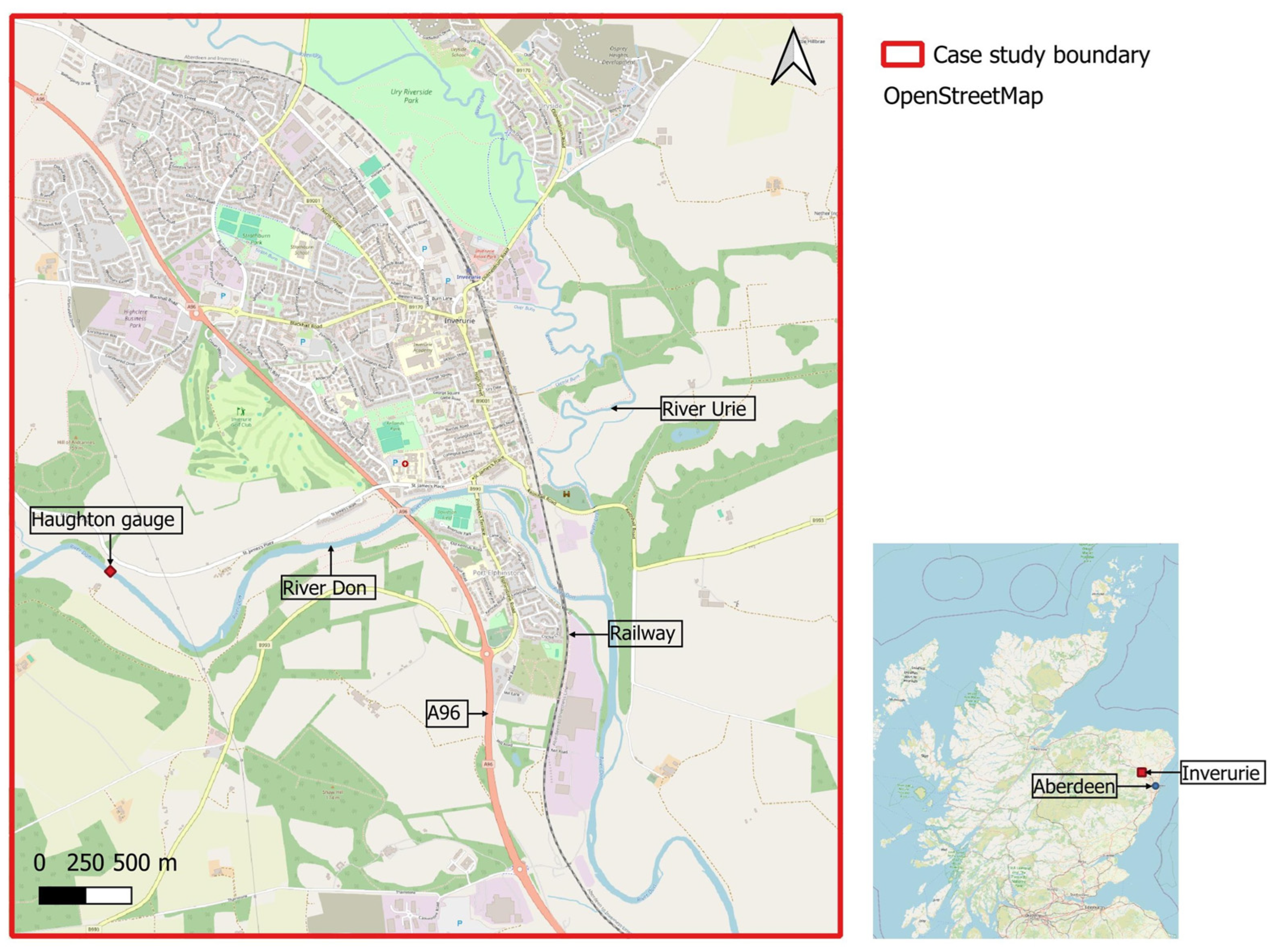
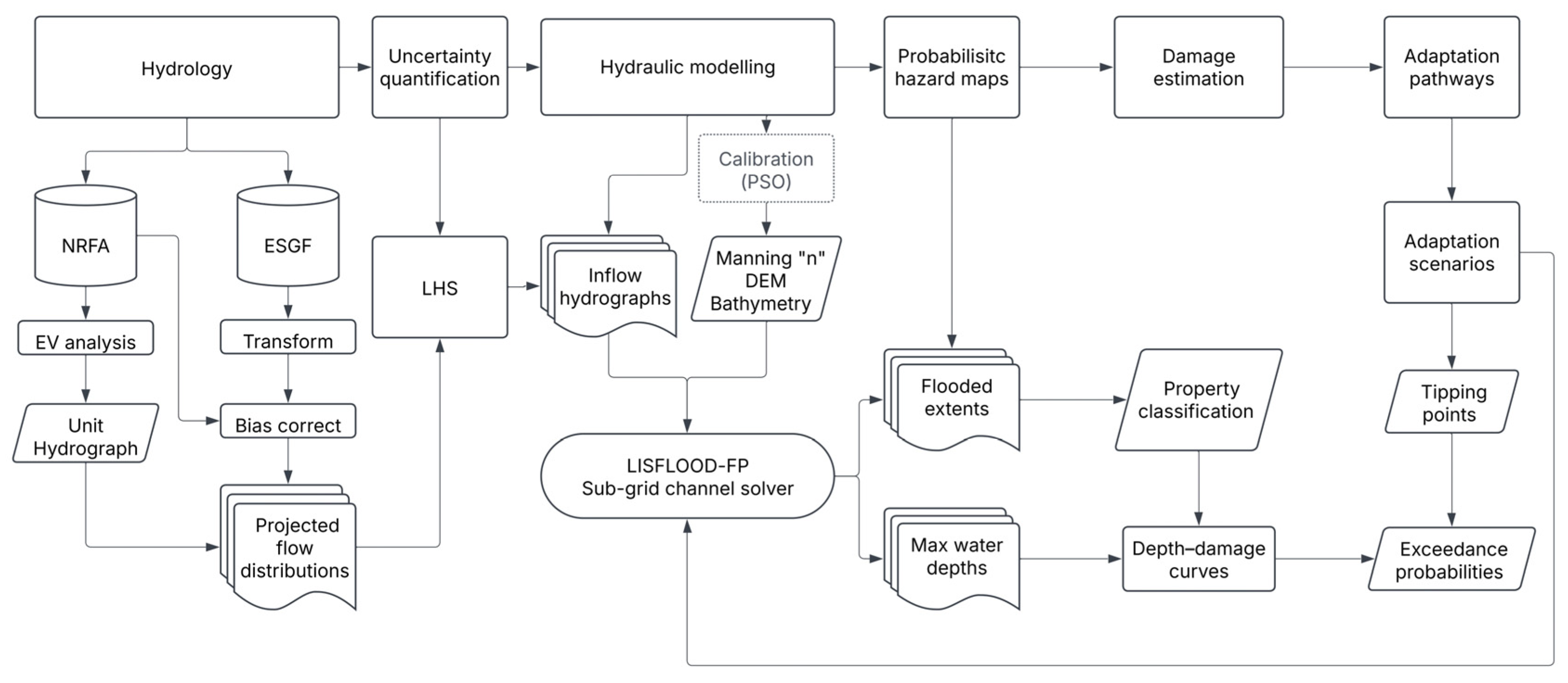

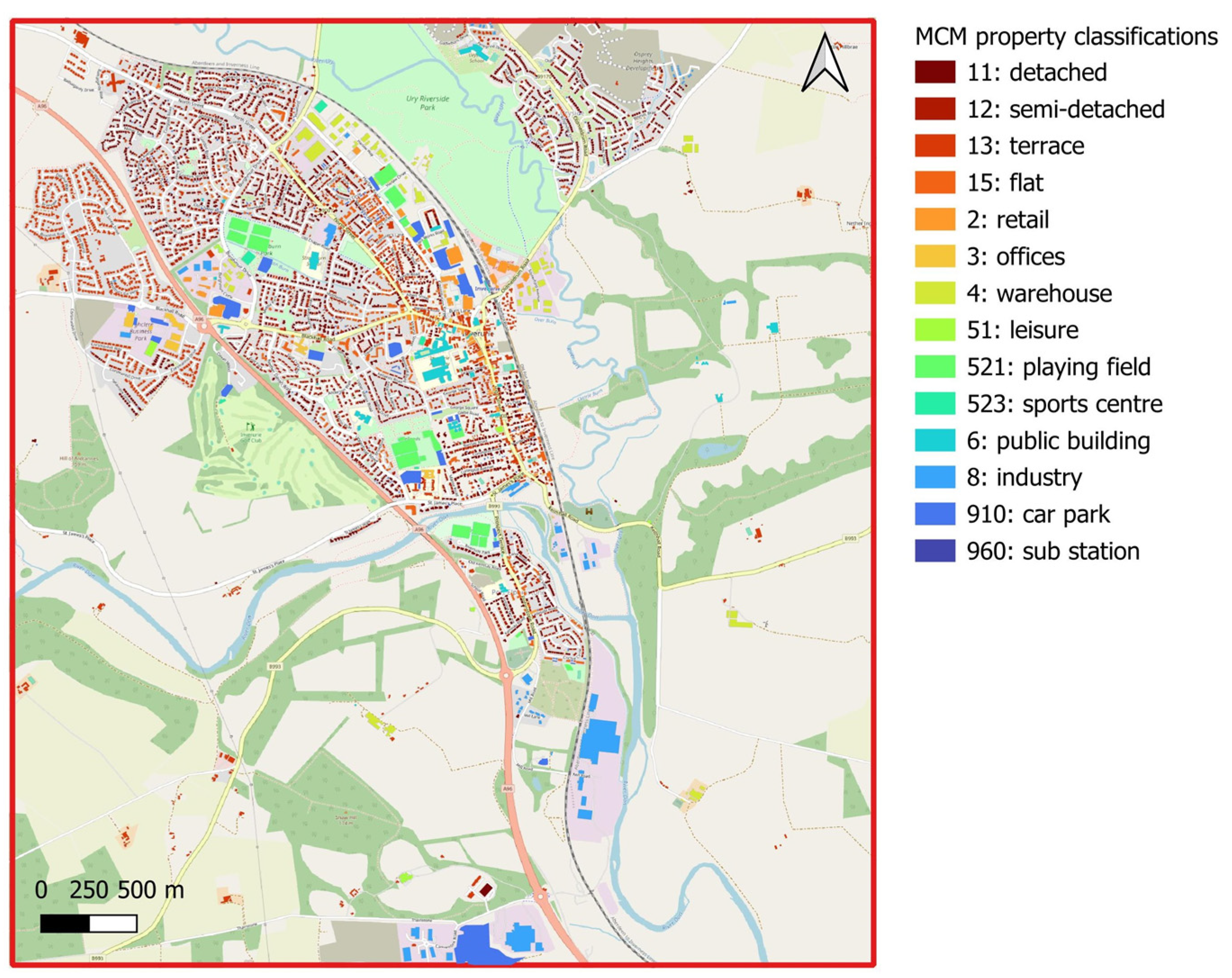

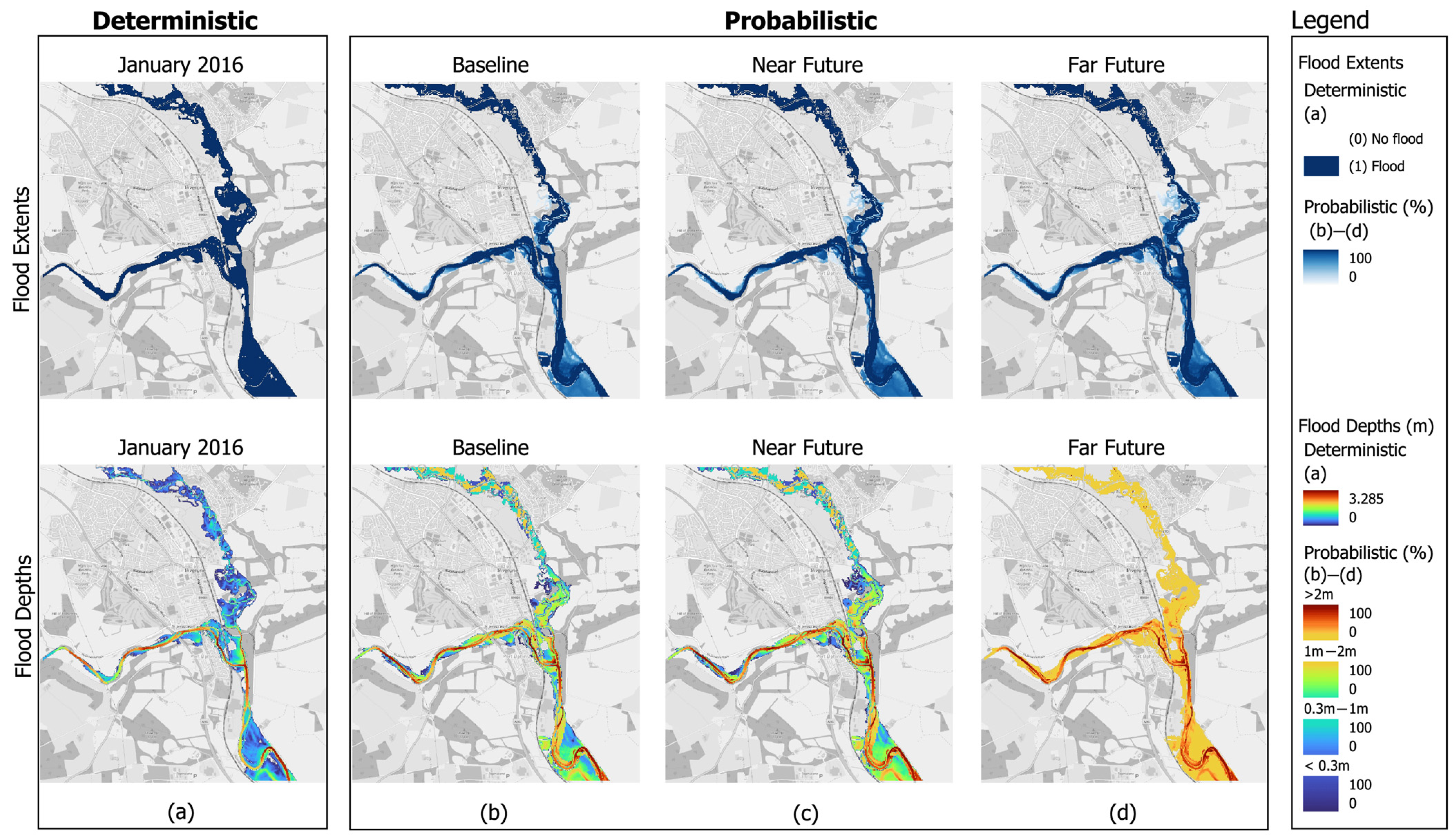
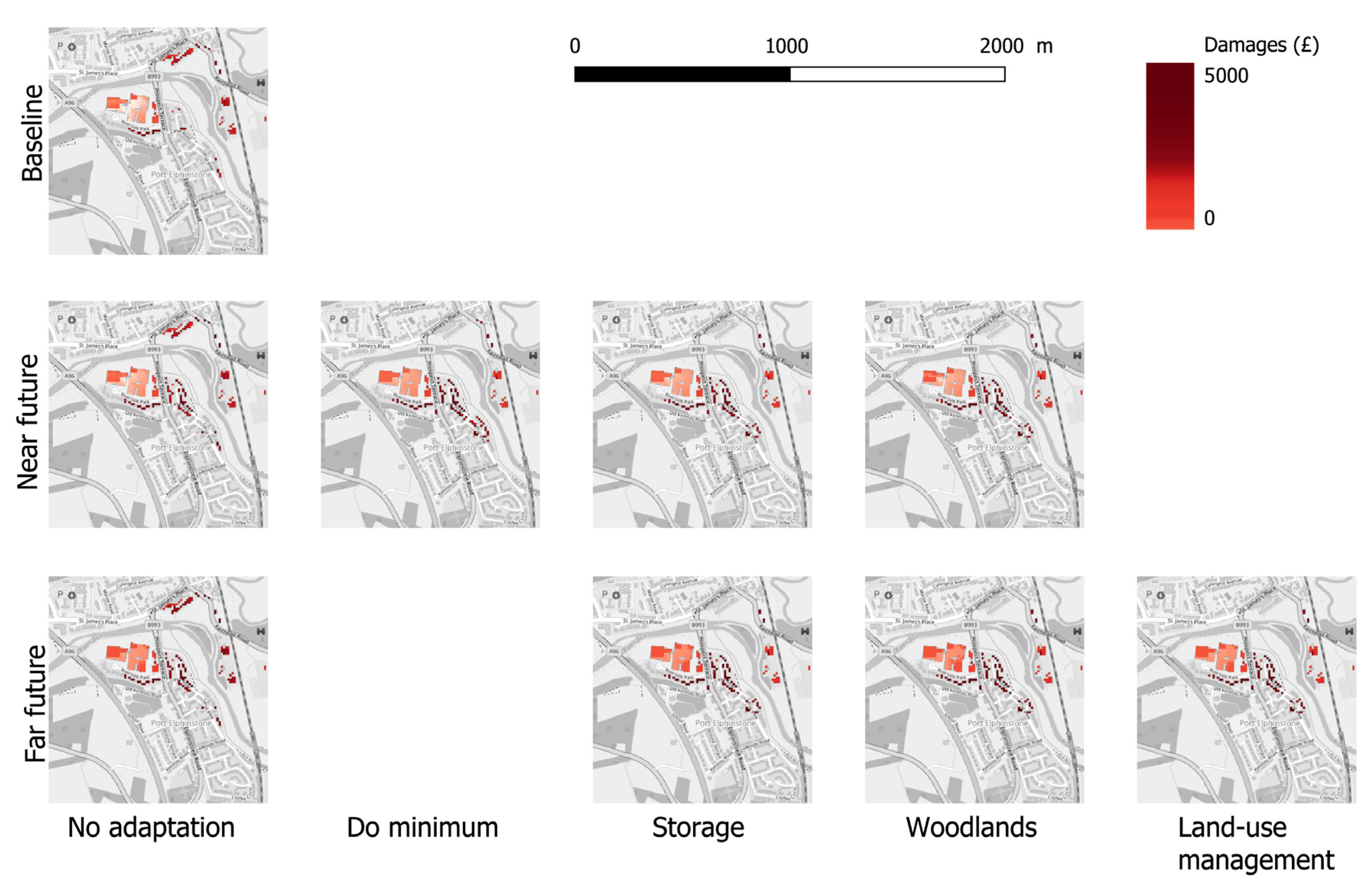
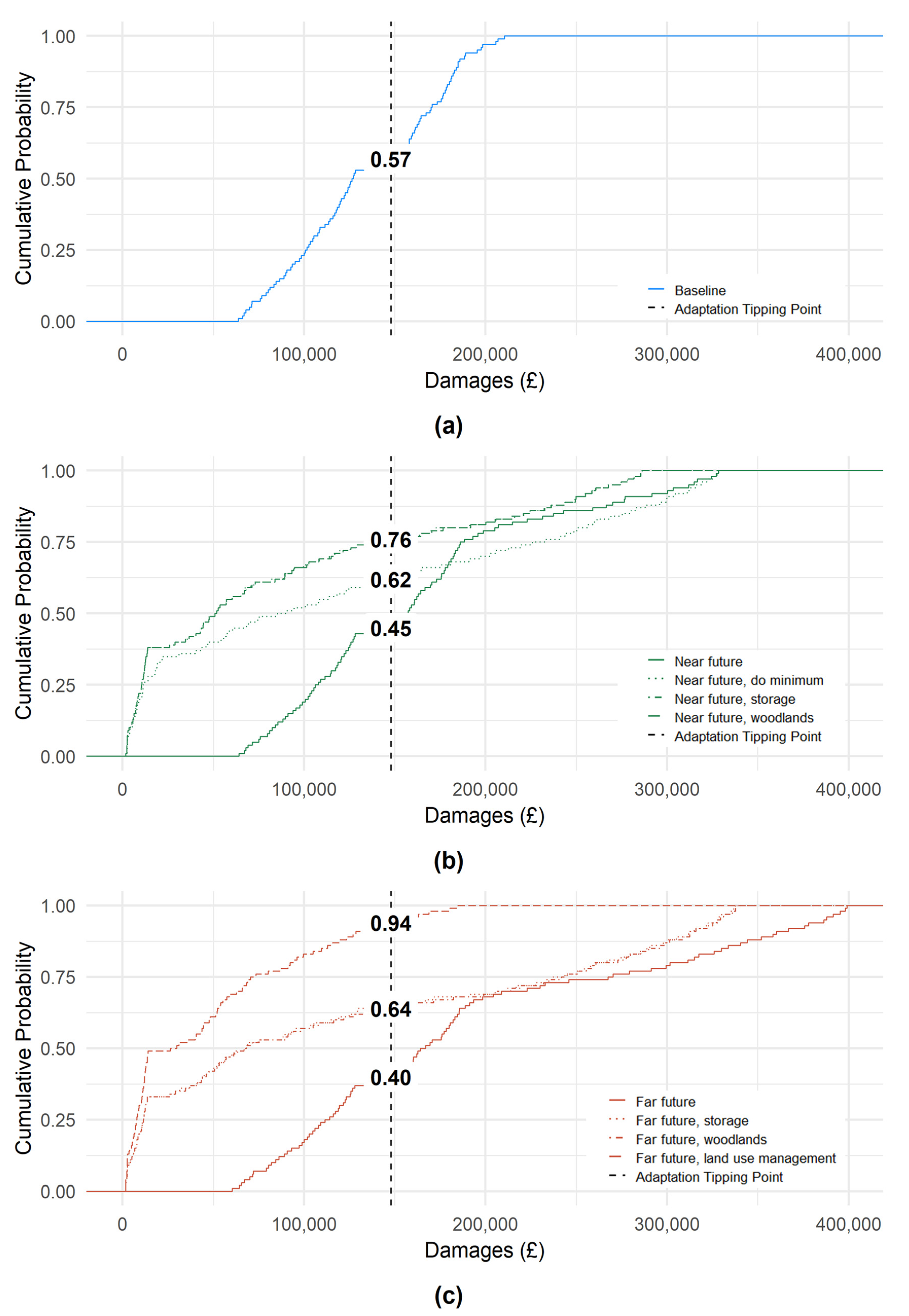
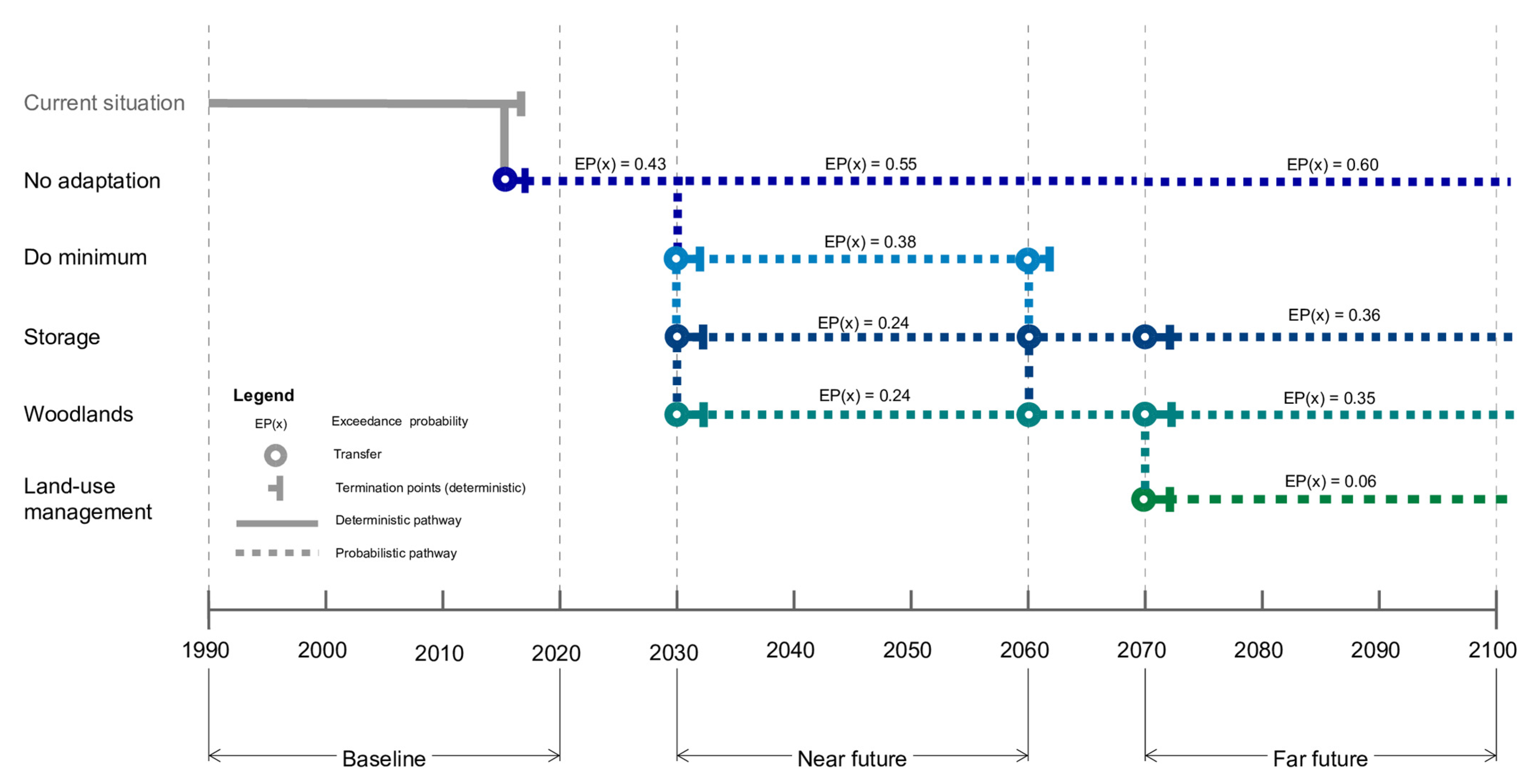
| Scenario | Time Horizon | Adaptation Actions |
|---|---|---|
| No adaptation | Baseline Near future Far future | None |
| Do minimum | Near future | Direct defences |
| Old canal restoration | ||
| Storage | Near future Far future | Increase floodplain storage |
| Woodlands | Near future Far future | Riparian woodland creation along the riverbanks |
| Land-use management | Far future | Whole-catchment woodland creation |
| Time Horizon | Lower Limit (m3/s) | Upper Limit (m3/s) |
|---|---|---|
| Baseline | 124.0 | 777.8 |
| Near future | 126.2 | 928.9 |
| Far future | 109.8 | 1075.9 |
| Scenario | Time Horizon | Total Damage (£) |
|---|---|---|
| January 2016 | ATP | 147,933.66 |
| No adaptation | Baseline | 175,576.20 |
| Near future | 273,502.31 | |
| Far future | 316,786.38 | |
| Do minimum | Near future | 261,469.62 |
| Storage | Near future | 224,552.60 |
| Far future | 260,089.96 | |
| Woodlands | Near future | 224,740.00 |
| Far future | 260,307.02 | |
| Land-use management | Far future | 233,057.62 |
Disclaimer/Publisher’s Note: The statements, opinions and data contained in all publications are solely those of the individual author(s) and contributor(s) and not of MDPI and/or the editor(s). MDPI and/or the editor(s) disclaim responsibility for any injury to people or property resulting from any ideas, methods, instructions or products referred to in the content. |
© 2025 by the authors. Licensee MDPI, Basel, Switzerland. This article is an open access article distributed under the terms and conditions of the Creative Commons Attribution (CC BY) license (https://creativecommons.org/licenses/by/4.0/).
Share and Cite
Dimond, J.; Roose, W.; Beevers, L. Making Different Decisions: Demonstrating the Influence of Climate Model Uncertainty on Adaptation Pathways. Water 2025, 17, 1366. https://doi.org/10.3390/w17091366
Dimond J, Roose W, Beevers L. Making Different Decisions: Demonstrating the Influence of Climate Model Uncertainty on Adaptation Pathways. Water. 2025; 17(9):1366. https://doi.org/10.3390/w17091366
Chicago/Turabian StyleDimond, Jessica, William Roose, and Lindsay Beevers. 2025. "Making Different Decisions: Demonstrating the Influence of Climate Model Uncertainty on Adaptation Pathways" Water 17, no. 9: 1366. https://doi.org/10.3390/w17091366
APA StyleDimond, J., Roose, W., & Beevers, L. (2025). Making Different Decisions: Demonstrating the Influence of Climate Model Uncertainty on Adaptation Pathways. Water, 17(9), 1366. https://doi.org/10.3390/w17091366








